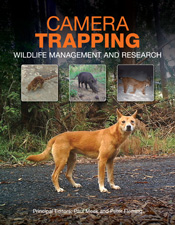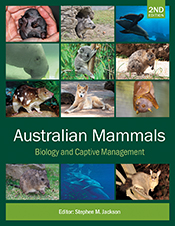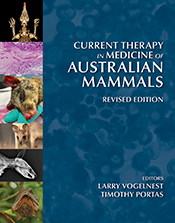News
This title is no longer available in print format, but can still be purchased as an eBook.
Reviews
"Any fauna researcher or wildlife manager who is considering, or already implementing, camera trapping is recommended to read this book... The editors have achieved the aim of bringing together and providing a benchmark of the international developments and uses of camera traps for monitoring wildlife for research and management."
Sally O'Neill, Ecological Management & Restoration 18(1), November 2016
"a goldmine of information"
Steven Simpson, Australian Hunter, 2015
"The strength of Camera Trapping: Wildlife Management and Research is that the papers describe real-world experiences while camera trapping... this book would serve as a useful primer to landmanagers and wildlife practitioners new to camera trapping."
Adam Duarte, The Journal of Wildlife Management 80(1), 2016, pp. 183-184
"If anyone or any organisation uses or intends to use camera traps as a survey tool, this is a useful volume as it covers all the information needed to carry out a successful camera trapping survey... If you are considering undertaking a camera trap survey, this book will provide a useful reference text."
Luke Woodford, The Victorian Naturalist 132(6), 2015, pp 183-184"
Details
ePDF | November 2014
ISBN: 9781486300402
Publisher: CSIRO Publishing
Available from
eRetailers
ePUB | November 2014
ISBN: 9781486300419
Publisher: CSIRO Publishing
Available from
eRetailers
Features
- Includes colour photo section of animals caught in action
- Camera trapping is an evolving area of science with little written about the technology before
- The most up to date synopsis of research being undertaken around the world on camera trapping
Contents
Preface
Acknowledgements
Introduction
Part 1: Camera Trapping for Animal Monitoring: Case Studies
Part 2: Camera Tech, Constraints & Pitfalls
Part 3: Survey Design
Part 4: Data Management and Analyses
Part 5: Conclusion
View the full
table of contents (PDF).
Authors
Paul Meek is an invasive species officer with the New South Wales Department of Primary Industry and an affiliate of the Invasive Animals CRC and the University of New England. Paul has worked as an ecologist throughout Australia including working on islands such as Christmas, Bowen and Mutton Bird, and has also spent time working overseas. He has been working in the vertebrate pest management and natural resource management fields for 26 years. He first started working with camera traps in 1999, trialling their applicability of detecting visitors to fox bait stations. Since this time he has been involved in camera trap research on Hastings River mice, native and introduced rodents, wild dogs, foxes, feral pigs, macropods and feral cats. Paul’s main camera trap interests are focused on evaluating the effectiveness of camera traps and testing the robustness of these devices for research and monitoring purposes. He has published over 30 scientific papers and contributed to five books. In 2011 he was awarded a Churchill Fellowship to travel to Europe and the USA to investigate camera trap use.
Peter Fleming is an invasive species specialist with 28 years’ experience in research at the Vertebrate Pest Research Unit of the New South Wales Department of Primary Industries (NSWDPI). Invasive animal management is a core biosecurity and biodiversity interest and obligation of NSWDPI and his research informs state and national policy on exotic disease preparedness, invasive animal strategic management across tenures, and animal welfare aspects of control practices. Peter’s role is to conduct research into the impacts and management of invasive species for biodiversity conservation, mitigation of livestock predation and zoonoses, policy development and exotic disease preparedness. Peter is a part of a team of researchers investigating the use of camera traps for wildlife research and monitoring. His research has led to over 200 publications and presentations since 1985, including 52 peer-reviewed articles and the editing of a special issue of Wildlife Research on aerial survey methods, analyses and application in 2008.
Guy Ballard works in the Vertebrate Pest Research Unit, NSW Department of Primary Industries and is an adjunct lecturer at the University of New England. Since 2007 he has worked as part of a team undertaking research on mammalian predators (dingoes and other wild-living dogs, red foxes, feral cats and spotted-tailed quolls). During this time camera traps have become increasingly important tools, demanding effort to improve our understanding of their (and researchers’) various limitations. Guy, his colleagues and students use cameras to monitor predators and a variety of prey species, including brush-tailed rock-wallabies. Much of the work is funded through the Invasive Animals Cooperative Research Centre and is undertaken with the NSW National Parks and Wildlife Service, Forestry Corporation and Local Land Services.
Peter Banks is the president of the Royal Zoological Society and associate professor in Conservation Biology at the University of Sydney. His research examines the behavioural and population ecology of native and introduced mammals and aims to develop ecological solutions to pest management problems. In the last 5 years, wildlife cameras have become an integral part of the standard survey toolkit for his research group, studying the dynamics and behaviour of small rodents. These cameras have allowed insights into the ecology of rodents and their interactions with their food and predators that have previously been impossible to measure directly.
Andrew Claridge is a senior research scientist with the NSW National Parks and Wildlife Service. He has worked for over 20 years on issues around wildlife management in natural landscapes, mainly in Australia but also in the Pacific North-west of the United States. He has particular interests in developing ethical and humane methods for the census and monitoring of rare and cryptic wildlife and has used infrared digital cameras in his work extensively. So far, Andrew has co-authored three books relating to natural resource management and threatened species, and published or co-published over 100 peer-reviewed scientific papers in the same field.
Jim Sanderson received a PhD from the University of New Mexico (UNM) in 1976. After working for Los Alamos National Laboratory as a weapons code designer he returned to UNM and received his BS and MS in biology. He received his PhD in wildlife ecology and conservation from the University of Florida. He is a voting member of the IUCN Cat Specialist group, a Fellow of the Wildlife Conservation Network, founder of the Small Cat Conservation Alliance, director of International Programs at the University of Arizona’s Wild Cat Research and Conservation Center, and associate editor for The Wildlife Society Bulletin. He has studied small cats using radio-telemetry technology to understand habitat fragmentation and landscape connectivity. He did the first study of the guigna, a small cat in Chile, and with his colleagues was the first to capture and radio-collar an Andean cat. He has also used camera phototraps to survey wildlife populations and monitor biodiversity in South America, Africa, China and south-east Asia. Jim’s photograph of the Andean cat appeared in the February 2000 issue of National Geographic. He has written four books and published more than 120 peer-reviewed journal articles.
Don Swann is a biologist at Saguaro National Park, Arizona, USA. His major responsibilities include support of long-term monitoring, research and management of many natural resources in national parks, including wildlife (mammals and herpetofauna), plants, and desert waters. Don attended Brown University in Providence, Rhode Island, and received his MSc in Wildlife and Fisheries Ecology from the University of Arizona. He is lead author or co-author of scientific papers on a wide range of topics, with a special interest in the uses and technology of camera traps. Don’s current projects include using a large number of randomly distributed camera traps to monitor changes in species richness of mammals, as well as using camera traps in educational programs at Saguaro National Park.








